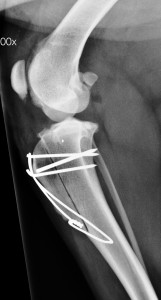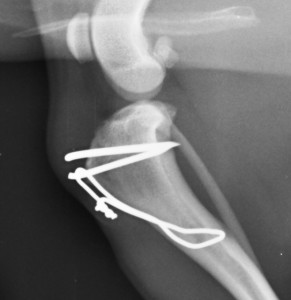The patella (knee cap) can sometimes luxate (dislocate) from the groove in which it should run. This groove is found on the front of the bottom of the femur (thigh bone), and forms part of the stifle (knee) joint.
The quadriceps muscle on the front of the thigh pulls on the patella, and when it is pulled, the patella should run up and down in its groove. The patella ligament links the patella ligament to the front of the top of the tibia (shin bone). The patella ligament inserts (attaches) on the tibia at the tibial tuberosity/crest.
In people, luxating patella is typically a traumatic and excruciatingly painful problem. In dogs and cats, there usually seems to be very little discomfort associated with the patella luxating, as luxating patella is typically a developmental problem in these species rather than a traumatic one. We see luxating patellae commonly and in many breeds, including, for example, Cavalier King Charles Spaniels and Staffordshire Bull Terriers. It can affect both knees or just one. We sometimes see luxating patella associated with cruciate ligament rupture (covered in separate articles).
When the patella luxates, it is usually medially (inwards), but it can occasionally luxate laterally (outwards) in larger breed dogs. This leads to an inability to properly use the stifle (the knee joint). The dogs will often walk normally for a few steps and then carry the leg for a few steps as the patella is pops in and out. Cartilage damage and significant degenerative joint disease often develop.
Some small dogs, like Yorkies, can live with luxating patella without the owners knowing they have a problem. However, when mobility issues result, cases are often referred for surgery.
The solution we most commonly use is moving the tibial crest sideways and anchoring it in a new position that allows the patella to run smoothly in its groove. By moving the tibial crest into a new position, we aim to allow the line of pull of the quadriceps, the patella, the patella ligament and the tibial tuberosity to form a straight line that runs through the groove on the bottom of the femur. We anchor the tibial crest in its new position with pins and wire while it heals. Sometimes we need to deepen the groove itself, and sometimes we need to release or overlap the soft tissues on either side of the stifle.
Restraint from running/jumping is required during healing. The aftercare is described in the post-op care sheet for general orthopaedic surgery, which can be found on this website.
29th December 2013




